My Project:
This week, I will do a comprehensive review of my individual project.
- Floor plan rendering
Project title: Reinterpretation: Feminism in Opera Development
Keywords:
Opera, feminism, historical development, reimagining, contemporary art
Themes:
Exploring the origin and development of feminism in an ancient and great art form – opera, reinterpreting opera with contemporary perspectives and artistic creation methods, and stimulating people’s thinking on the continuous development of feminism by comparing the situation of women in the old times and the current lifestyle of women.
Venue:
Collective Gallery (EH7 5AA)
Reasons for Site Selection:
This venue is located on Carlton Hill, an area with a high volume of foot traffic. Given that the exhibition itself does not have a significant reputation, placing it in a tourist area with many visitors is a good choice. Additionally, since the exhibition is linked by a timeline, a circular exhibition hall is more capable of demonstrating the passage of time. Moreover, considering the budget for the exhibition, a smaller exhibition hall that does not require a large amount of funds is a better option.
(Following Adam’s suggestion, it was ultimately decided to set the exhibition venue at Summerhall, an art venue where multiple art forms coexist. It is located near The Meadows, with a large flow of people and a strong artistic atmosphere.)
Duration:
(2025.08.01-08.15) two weeks
The reason for choosing this period of time:
The Edinburgh International Festival will be held in August. During this period, there will be many theatrical performances, which are quite in line with the theme of this exhibition – opera. Besides, due to the holding of the festival and the fine weather and other reasons, the number of tourists will also increase, and more people will come to visit the exhibition.
Contents:
The entire exhibition will be divided into four sections. In the center of these four sections, there will be an interactive experience area where a mirror and a visitors’ comment book will be placed. By observing the differences in their own figures and clothing compared to those of women in the past in the mirror, visitors can reflect on the significance of women’s liberation and write down their thoughts in the comment book.
1.Historical and Costume Analysis Area
The focus of this section is a timeline that combines the history of opera with the development of feminism. The exhibition will showcase the evolution of women’s costumes in opera around this timeline. Visitors can also rent opera costumes in this area to experience the clothing of women in the old days. The experience lasts for two hours and there is a dedicated room for changing. Visitors can take photos and check in while wearing the costumes in the exhibition hall or on Carlton Hill.
2. Line Analysis Area
In this area, the changes in the dialogue of the four operas, Orfeo, Don Giovanni, The Marriage of Figaro and Carmen, will be analyzed in depth. These four operas are respectively from different periods of opera development, and the social status of women in them is also different. Additionally, an interactive area will be set up where the audience can try to read or sing the opera dialogues, immerse themselves in the roles, and attempt to think about how to change the tragic fate of female characters from a modern perspective.
3.Modern Deconstruction Workshop
The artists invited to this exhibition will display their works here and have two days to interact with the audience on site.
4.Cultural and Creative Products Selling Area
Collaborate with artists to design cultural and creative products related to the exhibition, such as postcards and badges, and attach QR codes to the products. By scanning the codes, viewers can access knowledge related to opera and feminism, thereby enhancing the promotion of the exhibition.
Artists:
1.Zhuorui Han(Cifa, the student in CAP)
- Zhuorui Han’s artwork
Her artistic works combine nature with human sexual organs, innovative and bold. Her works emphasize feminism. In all kinds of artworks, only female sexual organs have been emphasized all along. Therefore, she hopes to also boldly talk about male sexual organs in her works. She believes that this is a display of a female attitude and a declaration of war against the patriarchal society.
I think her artistic style is highly compatible with the re-deconstruction of feminism in the opera within my exhibition. Her bold and avant-garde artistic style forms a sharp contrast with the social oppression that women in the opera have suffered.
2.Sijia Chen(the student in CAP)
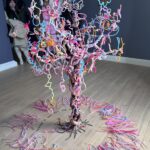
A family tree(Sijia Chen, CAP)
Sijia noticed that many families use the patrilineal clan system to compile their family trees. This tree woven with metal and silk threads represents the traditional family lineage. The colorful silk threads on the ground symbolize the awakening of feminism. Women are increasingly taking the lead in the family and society, and they have made the originally outdated system more dynamic. The more colorful silk threads on the tree, the more vigorous the tree is.
3.Xudong Jia(the student in Cap)
- Xudong Jia’s artwork
His works involve smashing the blue and white porcelain tea sets he found in the garbage dump and using them to mend the cracks in ancient buildings. Both the tea sets and the ancient buildings represent history, and their combination symbolizes a new artistic creation of old objects as well as the present. Through the re-creation of old objects, he expresses the span of time, which I think is very much in line with my exhibition. My exhibition emphasizes the use of a modern perspective to think about the lives of women in the old society depicted in operas.
Ethics:
1.Pay attention to the authenticity of history and carefully verify the sources of all historical documents.
2.Fully respect the copyright and intellectual property rights of the artist’s works, and fully respect the artist’s right to interpret their works.
3.Respect the rationality of the opera content within its historical context.
Budget:
Expenses
| Items | Quantity/Duration | Amount(s) |
| Venue rental | Two weeks | £2100 |
| Purchase of costumes | 10 | £600 |
| TV | 2 units / 14 days | £840 |
| Artist | 2 people / 5 days | £2264 |
| Other materials | (Display boards and display stands) | £500 |
| Cultural and creative products | 200(100 postcards + 100 badges) | £200 |
| Total | £6504 |
Imcome
| Items | Quantity | Amount(s) |
| Costumes rental | 10(10 pounds per piece, two weeks) | £2800(Minimum) |
| Cultural and creative products | 200(Postcards:£2/each, Badges:£3/each) | £500(Minimum) |
| Total | £3300 |
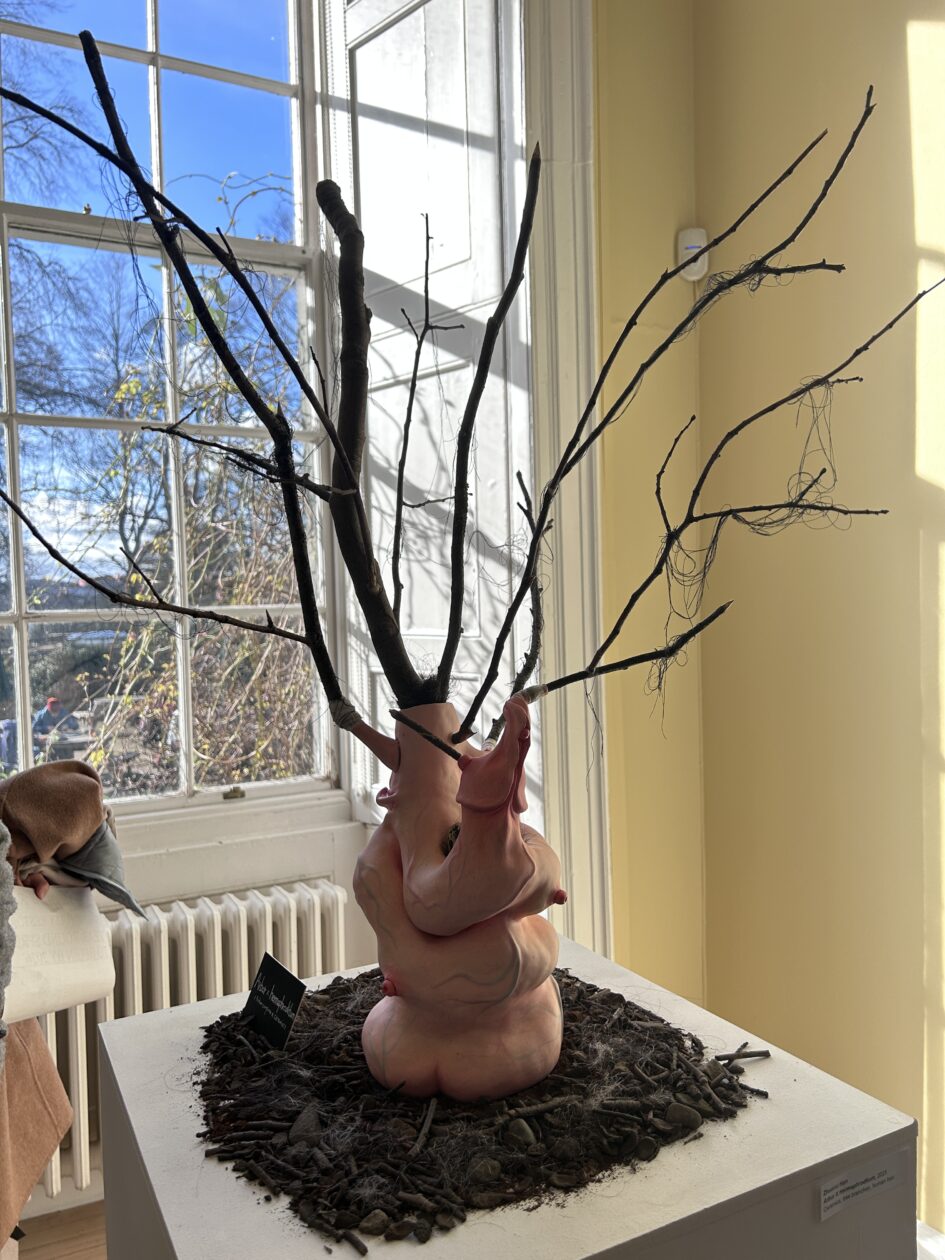
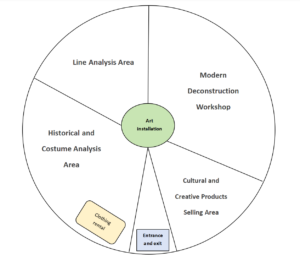
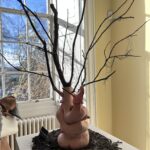
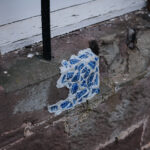


3 April 2025 at 12:58
My first piece of feedback relates to captioning and crediting the artists and images you use in your blog posts. It is important to do this as it acknowledges a deeper connection to the research you are conducting. Without clear captions, you do not provide all the necessary information, which makes your concepts less clear.
It’s great to see you engaging in secondary research and attending relevant events and exhibitions. These experiences will enhance your knowledge and prove helpful when you develop your own projects and exhibitions. However, it’s important to articulate what you learn and how these ideas relate to your own curatorial development.
Your writing style is often very personal and feels authentic to you. While there is still room for improvement, it’s great that you are developing your own unique voice. However, be careful when using AI for translations; you must reference any use (guidelines can be found on Learn). Although AI can be a helpful tool, it’s important to edit any translations and put them into your own words.
I noticed that you are proposing to use the Collective Gallery. However, this may not be realistic, as the gallery typically programs at least a year or two in advance. Additionally, it has a dedicated curator, making it unlikely that they would include any other curator’s project in their program. I would advise you to consider a more suitable venue. Speak with your peers, as they may have some good suggestions.
My final piece of advice is to make sure you post every week and that each post reflects the development of your ideas and includes relevant references to curatorial theories explored in the course lectures and secondary research that you carry out independently.
Below is some useful information that will help you improve future posts.
To enhance future blog posts, refer to JL’s slides presented this week, as they break down some of the subheadings.-
https://www.learn.ed.ac.uk/ultra/courses/_117082_1/outline/file/_11117495_1
For every Blog Post: ask yourself how can I connect this with the 11 weeks of lectures and learning, the themes, and the course resources?
• A reminder to look at the reading list on Learn for extra resources.
• You must include your independent research and course materials.
• Exhibition research, and the curatorial texts from named exhibitions, are a
key part of this material.